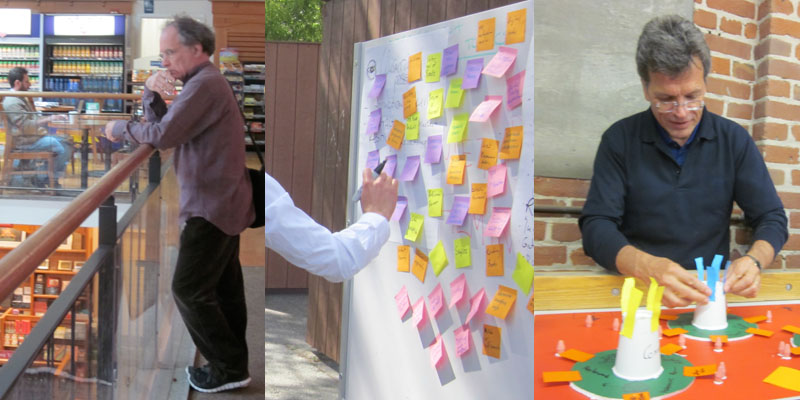
Cowritten by Dr. Bettina Maisch

Breakthrough ideas are hard to come by and, once created, become difficult to explain to experts and impossible to convey to laymen without drowning in verbiage. However, creating and using vivid, imaginative and comprehensive metaphors can arm a team with a shared sense of what is needed and help to synchronize their efforts. This may, perhaps, make intuitive sense to us all; however, actually experiencing this process will make one a true believer.
Our conversion to metaphor evangelists took place during a workshop held at Stanford University last spring. Small groups of researchers were charged with the task of competing to reinvent the bookstore experience and we had only three hours in which to make this happen. Each team divided up into pairs and descended upon the nearby Stanford Bookstore, armed with cameras, microphones and notebooks and began using Design Thinking, which is the process of identifying needs, doing ideation, prototyping, selecting, implementing and learning from the process.
The Stanford Bookstore resembles a Middle Eastern bazaar and just about anything is for sale there with the bulk of its profit obtained from T-shirts, hats, mugs, pens and whatever else one can imagine with an big Stanford "S" emblazoned upon it. Locating a needed book or browsing the shelves for inspiration, one can have the feeling of being at a supermarket sales event.
After an hour of dispersed bustling through the bookstore, the teams' members reunited to compare notes. Using yellow sticky notes, insights were grouped in a matrix according to user needs and bookstore offerings. With only an hour to the deadline, we had yet to create a concept and prototype our innovation. Exactly what kind of book shopping experience did we wish to experience?
Ideally, we wanted to have a serene experience and we also wanted to create a unique place where we could meet, enjoy and share what we love: exciting stories. From this shared vision, the metaphor of a "Stonehenge" was born.
Once everybody on the team had "Stonehenge" in mind, we could conjure up the prehistoric monument located in England where the legends of Merlin, Uther Pendragon, Arthur and the round table still live. With this vivid and powerful picture in mind, iterations of ideation, prototyping, selecting and implementing progressed as if it were a jazz jam session. With this vivid metaphor as a guide, the team quickly established useful functions, turned them into features and integrated these into a rough prototype of our "Stonehenge experience."
At the end of the three hours, our team had acted out the most comprehensive and breakthrough proposal for the reinvention of a book shopping experience. We had envisioned a "Stonehenge experience" supported by a store divided into a number of virtual interactive sections where shoppers with similar interests, would be grouped around columns with multi-displays addressing shared themes. Users could interface with the "Stonehenge" using WiFi and could search, read, download and pay for digital content, as well as interact with like-minded individuals. Circling the columns, conveyer belts provided everything non-digital, from books printed on demand, to Stanford memorabilia and a fresh café latte.
With the help of this strong defining metaphor, our team enjoyed a creative jam session, while transforming a Middle Eastern bazaar into a "Stonehenge" haven and experiencing a real breakthrough innovation.
Special thanks to Dr. Bettina Maisch for researching and co-writing this article.